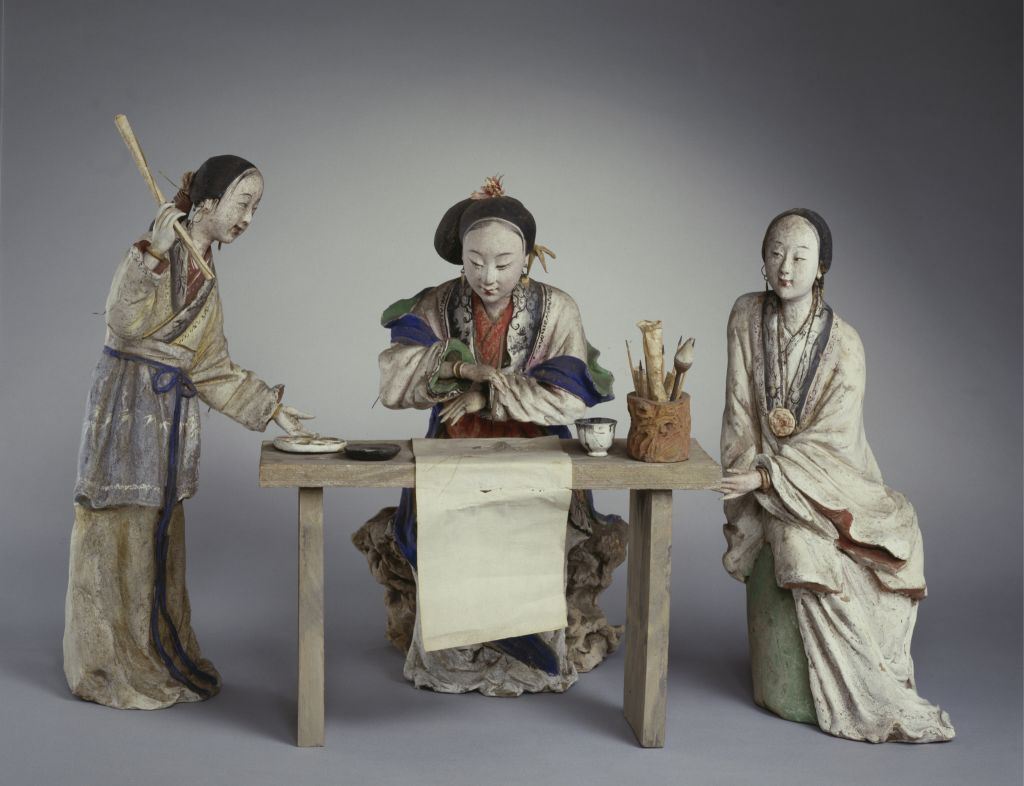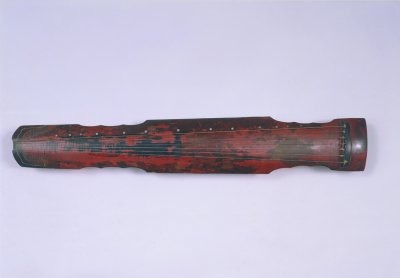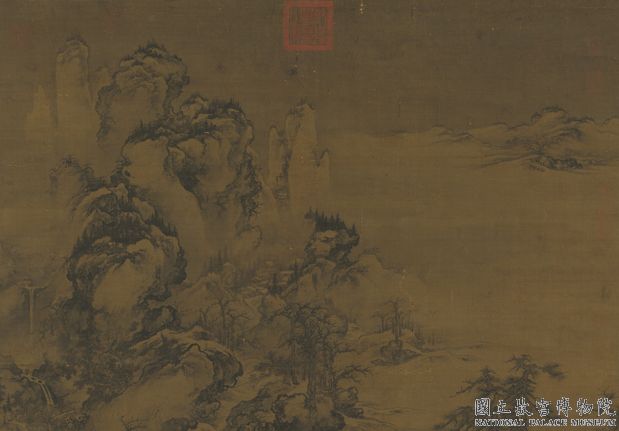[Painter surnamed Ding’s Five Harmonies]
The Five Harmonies Painting Volume, Ming Dynasty, silk version, color setting, vertical 41 cm, horizontal 181 cm
This picture has no style. At the beginning of the scroll is Cai Zhiding’s seal book, “Five Tonghui Diagram”, and the seal is “Cai Zhiding Seal” and “Tamarihushan Man”. The original postscript has disappeared. After the present volume, there are Wu Kuan’s Preface to the Five Harmonies Meeting and the Five Harmonies Meeting Poems edited by Yan Chun in the 11th year of Jiaqing’s reign in the Qing Dynasty (1806), Wu Kuan’s New Year’s Five Harmonies Meeting with Yu You, Shixian, Yu Chou and Ji Zhi, Yu Ru’s invitation to drink with poetry, and Yu Ru’s return to the Chu prison at the beginning of his reign due to the second rhyme, Wang Ao’s two poems “After the Five Harmonies Meeting with the original rhyme theme”, “The Five Harmonies Meeting with the second rhyme Yu Ru”, and Chen Renxi’s postscript, Chen He (the 11th grandson of Chen He) praised five poems and Yan Chun’s postscript, followed by Weng Fanggang’s postscript, Qin Ying’s postscript, Weng Fanggang’s postscript, Fashi Shan’s postscript in the 12th year of Jiaqing (1807), Peng Ling’s postscript in the 13th year of Jiaqing (1808), Han Shisheng’s postscript in the 15th year of Jiaqing (1810), Cai Zhiding’s postscript in the mid-winter of the 14th year of Jiaqing (1809), Li Xi’s poem, Yao Nai’s poem, and Ni Bojing’s poem
According to the transcript of Chen Renxi’s grandson, the original five copies of this picture were “five people each copied the pictures and collected them from different families, and displayed them at the age of to dispel the sense of separation and reunion”. Later, the copies of Chen’s family were destroyed by fire. According to the postscript of Yan Chun’s 11th year of Jiaqing, Chen Zhonglin, the grandson of Chen Chun’s 11th generation, obtained this copy again and transferred it to his brother Chen He. At that time, only the picture scroll was left. “The picture has no style”, but the above Wu Kuanxu, poems and Wang Ao’s poems were transcribed. According to Weng Fanggang’s poems and notes, Zhu Yizun once saw the Wu Hong’s collection at the Sun’s house of Wu Hong V in the early Qing Dynasty; According to Han Shishengba, about 1750, his father also watched the Wu Hongs collection. In addition to this book, there is another one in Shanghai Museum, which should be Wu Hongjia’s collection or another
This picture depicts the elegant gathering activities of five senior officials from Suzhou in Beijing at the end of Hongzhi in the middle of the Ming Dynasty. According to the Preface to the Wutong Meeting written by Wu Kuan in the 16th year of Hongzhi (1503) of the Ming Dynasty (according to the forty-fourth volume of Wu Kuan’s Collection of Family Collections, Yan Chun recorded “the 18th year of Hongzhi”), the so-called “Wutong” means “the same time, the same country, the same dynasty, and the same comrades, the same way, because the name is called the Wutong Meeting, also known as the five ears of the same people”. “The Wu people who came out of the country and became officials are in the ascendant in the world, and now only five people are outstanding at that time”. From the beginning of the scroll, the characters in the painting are Wu Kuan, the minister of rites, Li Jie, the minister of rites, Chen Yu, the chief of the Zuo Jindu imperial court of the Nanjing Metropolitan Procuratorate, Wang Ao, the minister of officials, and Wu Hong, the minister of the Taipu Temple. The five people are all from Suzhou, and are officials of the imperial court. They share the same ideals. “Last year, the five people will have wine and food at their leisure”. Different from the general collection of refined works, they “sit with their teeth fixed, talk with their voice harmonic, look at the right way, and discriminate with their doubts. The rise of interest is in the form of singing, and the feeling of things is in the form of discussion, which is also called the rebellious in ancient times”. At first, the five people could get together and often get together, but soon Chen Chao was promoted to the post of the left deputy governor of the Nanjing Metropolitan Procuratorate. Wang Ao left Beijing for some reason, and only three of the party members were left. Wu Kuan sighed that he was old and would retire again. Although there might be new people coming to revive the party, I’m afraid it would be too late. From Wu Kuan’s preface and poems, the scroll should record the last meeting of five people as a souvenir
In the picture, five people are dressed in official clothes, with a natural and peaceful manner and elegant charm. The atmosphere of the scene is harmonious, making people feel the fit between each other. The characters are divided into two groups: on the right, Wu Kuan and Li Jie sit on Arhat’s bed, with Wu Kuan as the oldest. Wu Kuan sat with his hands folded, his back arched, and his sideburns gray; Li Jie leaned slightly to the right, holding his knee with his left hand and his bed with his right hand. He looked concerned and seemed to be greeting. On the left, among the three people who are chatting with each other, Chen Xuan is the main one. Chen Chen walked in front of him, white and elegant; Wang Ao’s face was slightly square, and he was in high spirits. He stood together in the middle, listened attentively and courteously; Wu Hong looks kind, holding a belt in his left hand and a book in his right hand. He seems to feel happy. The picture takes the garden as the background and depicts exquisite craftsmanship. Cranes, elk and pine trees symbolize good luck and prolong the year, while books of zither and chess, plantain, bamboo and stone reflect the elegance of literati. In the back of the background, there are quite a number of pictures depicting the Banqiao and the broad river with Jiangnan flavor, which seems to deliberately arrange space to create the scenery of Jiangnan to comfort the countryside. In terms of painting, the five portraits, either on the front or slightly on the side, echo each other, and are first outlined in light ink, with subtle strokes. The color change is exquisite, and the color is bright and moist. It is first rendered with ochre and vermilion, and then the white one is powdered. The concave-convex changes naturally. The characters’ eyes, nose and lips are portrayed with extremely fine pens, showing different looks and characters. The exquisite brushwork can be seen in the mountains, trees, children and instruments in the background, reflecting the painter’s profound and exquisite realistic skills and painting style
As for the painters, according to Wu Kuanxu, “Yu Chou (Wu Hong) painted wonderful pictures of Ding Juncai of Yue people, wrote them as pictures, and decorated them as long scrolls”, the painter’s surname was Ding, who came from Zhejiang Province, and was probably a folk painter who lived in the capital. He had a private relationship with Wu Hong, but his life was not recorded in the history of painting
The Painting of the Five Harmonies is not only a masterpiece of the group portraits of the Ming Dynasty, but also an image of the collection of high-ranking officials and friends in the middle of the Ming Dynasty, providing a unique window for understanding the political situation, cultural customs and the relationship between Suzhou officials and Suzhou culture at that time.
![图片[1]-Painter surnamed Ding Five Tonghui scroll-China Archive](https://chinaarchive.net/Ming dynasty/painting/s58de18febcc60.jpg)

![[Qing Dynasty] British female painter—Elizabeth Keith, using woodblock prints to record China from the late Qing Dynasty to the early Republic of China—1915-China Archive](https://chinaarchive.net/wp-content/uploads/2022/11/image-191x300.png)



